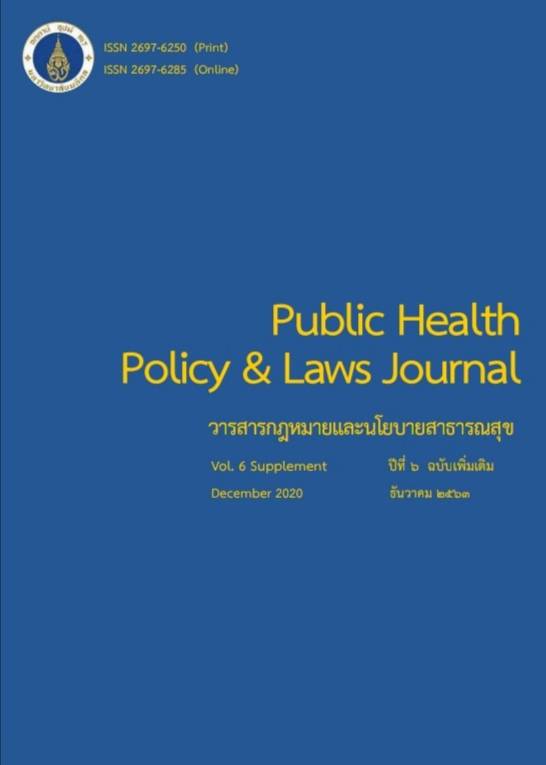Factors related to self-treatment with herbal medicine of Maechan hospital, Chiang Rai
Keywords:
Herbal medicine, Health care behaviors, Healthcare staffAbstract
This research was a cross-sectional study the factors associated with the use of herbal medicine behavior in the self-health of mae chan hospital personnel. A sample size was consisted of 220 Data were collected by using questionnaires. Analyzed by using percentage, mean, and standard deviation, Chi-square statistics.
Result found mostly females (76.4%), less than 40 years old(69.1%), without underlying diseases (82.7%), without a history of prior drug allergy (92.3%), married (52.3%), Graduated from higher education (65.9%), get monthly income more than 15,000 baht (58.6%), have been working more than 10 years (55.0%), Are employees (70.0%), In the profession (66.8%), with herbals usage (51.4%), And take an oral form of herbal medicine (81.4 %). A moderate level of knowledge and attitudes was (67.3% and 73.6% respectively) and a low behavior of using herbal medicines (77.3%). The factors associated to self-treatment with herbal medicine were sex, income, employment type, a past medical history found to be statistically significant with the herbal medicines behaviors Conversely, age, presence of underlying disease, a marital status, an education level, work experience, a history of herbal medicines usage, a level of knowledge about herbal medicines utilization and the perspective of using the herbal medicines benefits weren’t statistically significant
Conclusively, the sample had low behavioral use of herbal medicine in self-health care. It is due to its knowledge and attitude, the perception of the benefits of using low levels of herbal medicine. Therefore, it is best to start by educating the herbs in health care to create an attitude to the benefits of using herbs to take care of themselves as a basis for health care with herbal medicine.
References
กฤติเดช มิ่งไม้. (2560). ความรู้ ทัศนคติ และพฤติกรรมการใช้ยาสมุนไพรของผู้สูงอายุที่มีโรคเรื้อรังในอำเภอท่าเรือ จังหวัดพระนครศรีอยุธยา. วารสารสมาคมเวชศาสตร์ป้องกันแห่งประเทศไทย. 9(1):87-100.
ฉัตรณรงค์ พุฒทอง และคณะ. (2561). ปัจจัยที่มีความสัมพันธ์กับพฤติกรรมการดูแลสุขภาพตนเองด้วยวิถีการแพทย์แผนไทย และการแพทย์ทางเลือกของอาสาสมัครสาธารณสุขประจำหมู่บ้าน อำเภอทุ่งเสลี่ยม จังหวัดสุโขทัย. วารสารพยาบาลกระทรวงสาธารณสุข. 28 (3): 156-165. available from https://he02.tci-thaijo.org/index.php/tnaph/article/view/164225
ชนิภรณ์ กองถวิล. (2561). ปัจจัยที่มีความสัมพันธ์กับพฤติกรรมการใช้พืชสมุนไพรพื้นบ้านในการดูแลสุขภาพตนเอง ของประชาชน อำเภอเมือง จังหวัดตรัง. วิทยาลัยการสาธารณสุขสิริธร จังหวัดตรัง. available from http://cdea. scphtrang.ac.th/node/182
ธนากร ประทุมชาติ. (2557). การสั่งใช้ยาสมุนไพรของเจ้าหน้าที่สาธารณสุขที่ปฏิบัติงานในโรงพยาบาลส่งเสริมสุขภาพตำบล จังหวัดหนองบัวลำภู.
The National Graduate Research Conference. 3(1): 97-112. available from https://home.kku.ac.th/chd/index.php?option=com_ attachments&task=download&id=82&lang=th
พนธกร เหมะจันทร และคณะ. (2562). ความรู้ เจตคติ และพฤติกรรมการใช้ยาสมุนไพรในผู้ป่วยโรคเบาหวานและความดันโลหิตสูง ศูนย์เวชปฏิบัติครอบครัว โรงพยาบาลพระนครศรีอยุธยา. วารสารสมาคมเวชศาสตร์ป้องกันแห่งประเทศไทย 9(1): 87-99. available from https://he01.tci-thaijo.org /index.php/JPMAT/article/download/190882/133420/
เมธี สุทธศิลป์ และคณะ. (2560). การใช้สมุนไพรสปานาโมของผู้บริโภคผลิตภัณฑ์ที่มาซื้อในศูนย์กระจายผลิตภัณฑ์ในเขตอำเภอเมือง จังหวัดลำพูน. วารสารมหาวิทยาลัยราชภัฏยะลา. 12 (ฉบับพิเศษ): 42-55. available from https://so04.tci-thaijo.org/index.php/yru_human/article/view/133720/100177
วิริญญา เมืองช้าง. (2559). ปัจจัยที่มีความสัมพันธ์กับพฤติกรรมการใช้สมุนไพรในการดูแลสุขภาพตนเองของประชาชนในอำเภอแม่ใจ จังหวัดพะเยา.วิทยานิพนธ์หลักสูตรสาธารณสุขศาสตรมหาบัณฑิต คณะสาธารณสุขศาสตร์ มหาวิทยาลัยธรรมศาสตร์. available from http://ethesisarchive.library.tu.ac.th/thesis/2016/TU_2016_5817035164_6790_4790.pdf
สุกิจ ไชยชมพู และคณะ. (2555). ปัจจัยที่มีความสัมพันธ์กับพฤติกรรมการใช้สมุนไพรรักษาโรคของประชาชน ในเขต 11 กระทรวงสาธารณสุข.วารสารเกื้อการุณย์. 19(2): 60-74 available from https://www.western.ac.th/media/attachments/2017/12/06/004-11-1.pdf
สุรพจน์ วงศ์ใหญ่. (2563). การพัฒนาสมุนไพรไทยสู่ตลาดโลก ไทยมีความพร้อมในการเข้าร่วมแข่งขันหรือไม่ ที่นี่มีคำตอบ. available from: https://
www2.rsu.ac.th/sarnrangsit-online-detail/herb01
สมชาย เกิงฝาก. (2562). จังหวัดเชียงรายประชุมความคืบหน้าการพัฒนาเมืองสมุนไพรระดับจังหวัด. available from http://thainews.prd.go.th/th/news/detail/TCATG190529143525234
Best, John W. (1977). Research in Education. 3 rd ed. Englewood Cliffs. New Jersey: Prentice Hall, Inc.
Krejcie, R. V. & Morgan, D. W. (1970). Determining Sample Size for Research Activities. Educational and Psychological Measurement, 30(3), pp. 607-610.
Likert, Rensis. (1967). The Method of Constructing and Attitude Scale. In Reading in Fishbeic,M (Ed.), Attitude Theory and Measurement New York: Wiley & Son;.p. 90-5.
Downloads
Published
How to Cite
Issue
Section
License
Disclaimer and Copyright Notice
The content and information presented in articles published in the Journal of Law and Public Health Policy represent the opinions and sole responsibility of the respective authors. The editorial board does not necessarily agree with or assume any responsibility for the views expressed.
All articles, data, content, images, and other materials published in the Journal of Law and Public Health Policy are the intellectual property of the journal. Any individual or organization wishing to reproduce, distribute, or otherwise use the entirety or any part of such materials must provide proper citation.





